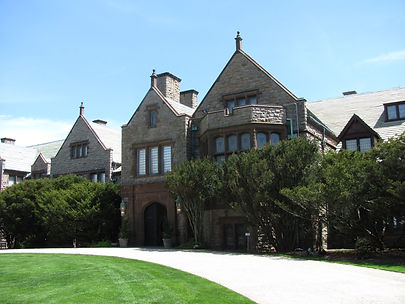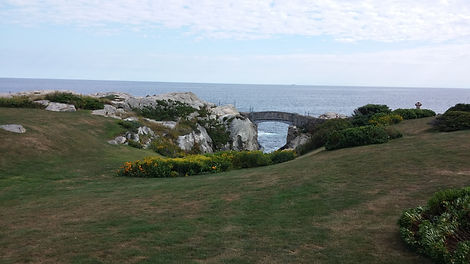
People & Places Of the Gilded Newport Mysteries

Who's Who: The First Four Books
MURDER AT THE BREAKERS

The first Cornelius Vanderbilt, born in 1794 to a modest Dutch-American family, nicknamed the Commodore, began his empire with a modest freight ferrying service in the Manhattan-Staten Island area, before expanding into the burgeoning railroad industry. After buying up underdeveloped railway lines, he founded the New York Central Railroad, and was worth $100 million when he died in 1885.


Alice Gwynne Vanderbilt, wife of Cornelius II, the daughter of an old New England family, embodies the spirit of the new "modern" era by dressing as "Electric Light" for her New York costume party in 1883.
During her lifetime she was "The Mrs. Vanderbilt," and maintained a fierce competition with her sister-in-law, Alva.
Cornelius Vanderbilt II, featured in MURDER AT THE BREAKERS, was the Commodore's grandson (father was William Henry Vanderbilt) He inherited jointly with his brother, Willie K., but was considered the head of the Vanderbilt family. Unlike the flamboyant and athletic Willie K., Cornelius was considered stately, almost boring, and while he and his wife, Alice, lived sumputously, theirs was a relatively sedate lifestyle. The Vanderbilts purchased The Breakers, then a rambling, shingle-style house, in 1885. It burned to the ground in 1892, and Richard Morris Hunt was commissioned to design the Italian-inspired palazzo we see today. (Portrait by John Singer Sargent)

The original Breakers, destroyed by fire in 1892



A portion of The Breakers' Great Hall, where the Vanderbilts held their summer balls.


Siblings Cornelius III, or Neily as the family called him, and Gertrude, whose coming out ball was held at The Breakers in August 1895, as featured in MURDER AT THE BREAKERS. Neily was no lightweight millionaire's son. He obtained a masters degree in engineering from Yale and, working at his father's NY Central for a modest salary, invented such significant improvements to rail travel that he was hailed a genius in his field.

The inspiration for Gull Manor, Emma's (entirely fictional) property on Ocean Avenue. This house, however, is a bit larger than what I describe as Emma's.

A young Nellie Bly, Gilded Age journalist who helped inspire the character of Emma Cross. In 1888, Bly traveled alone around the world in under 73 days, beating the fictional record of Jules Verne's Phileas Fogg in AROUND THE WORLD IN EIGHTY DAYS. At a time when most female reporters (of whom there were few) were relegated to the society columns, Bly stubbornly proved her mettle by seeking out hard news. In 1887 she had herself committed to an insane asylum, an undercover assignment lasting 10 days, in order to investigate and bring attention to the appalling conditions suffered by mental patients.
MURDER AT MARBLE HOUSE



The plot of Murder at Marble House revolves around young Consuelo Vanderbilt, considered the beauty of the Vanderbilt Family. She was the daughter of Cornelius's brother William, or Willie K. as he was called, and this woman --
the fiery and formidable
Alva Erskine Smith Vanderbilt, later Alva Belmont,
Who very much wanted her daughter to marry
the Ninth Duke of Marlborough


Charles Spencer Churchill, 9th Duke of Marlborough, had very little in common with Consuelo, not that he saw that as a problem. He wanted her, after all, for the vast fortune she would bring to the marriage.
And while the battles waged as to whether Consuelo would marry the Duke and her mother held her a virtual prisoner at Marble House until she made "the right decision", her father, William Kissam Vanderbilt., spent most of his time on his yacht, The Valiant, out on Narragansett Bay , out of harm's way...



In the story, I gave Consuelo a cat, Muffy, because I couldn't bear to think of her sitting in her room, alone, frightened, and sad...

What happens next--a murder, a disappearance--sends Emma Cross scrambling to solve a mystery, prevent another death, and save a reputation. Her sleuthing brings her here, to the Rose Island Lighthouse...

And back here, to the Newport County Jailhouse, which also served as the police station during the time of these stories. By the way, it's now an Inn.


And two doors down from that, you'll find The White Horse Tavern, continually in use since the 1673. Emma has dinner there with a certain alluring gentleman...
Across the street from the Jailhouse is St. Paul's Church, where Emma attends services (as does my father-in-law, by the way.)
Meanwhile back at Marble House...

The Gold Room, where Alva convinces Emma to help her persuade Consuelo to marry the Duke.

The entry hall and staircase. Very beautiful, but very cold. Intimidating, yes, but welcoming?
A Suffragette theme runs through Murder at Marble House. Ironic, considering Alva was trying to force her daughter into an unwanted marriage. Or maybe not so ironic. Years later Alva would take up the call and host many a Suffragette rally, sometimes right here on the veranda of Marble House. It would become a cause that brought mother and daughter together and mended old rifts.

MURDER AT BEECHWOOD

The house has been completely gutted as part of the restoration plans to bring Beechwood back to its Gilded Age condition. Once completed, the house will once again be open to the public and will feature an art museum.
Beechwood was the Summer Cottage of William Backhouse and Caroline Schermerhorn Astor. Pictured to the left is Beechwood as most people today would know it, unless you've visited Newport within the past couple of years. This is how it looks today...


During the Gilded Age Caroline Astor was hailed as THE queen of society. Being from "old money," she decided who made the social register and who did not. Those who did were considered part of The Four Hundred, named, so the story goes, for the number of individuals who could fit comfortably into Mrs. Astor's New York Ballroom. As society's Grand Dame, it was her job to usher in the summer Season's festivities each year, as is the case in Murder at Beechwood.

The Ballroom at Beechwood, as featured in MURDER AT BEECHWOOD
As unforgiving a society matron as Mrs. Astor could be, she loved her daughter, Carrie, very much. It was for Carrie's sake that Mrs. Astor relented and recognized the "nouveau riche" Vanderbilts as part of society. Carrie very much wanted to attend a ball held by Alva Vanderbilt, but she could not be invited until her mother first went to call on Mrs. Vanderbilt and extended her approval to the family. Later, when Carrie wished to marry, her mother objected to her daughter's choice. But when Carrie proved determined, Mrs. Astor accepted the situation rather than lose her daughter forever.


In Murder at Beechwood, one of Mrs. Astor's guests falls overboard during a yacht race. Or did he? Emma's search for clues takes her to the New York Yacht Club Station in Newport Harbor, pictured here in this vintage postcard. Emma brings along her Cousin Neily and her new friend Grace Wilson, but that doesn't necessarily mean she's safe from lurking dangers...

This is the NY Yacht Club in Newport today, Harbor Court, once owned by
John Nicholas Brown and family.

In these first three Gilded Newport Mysteries, I trace the courtship of Neily Vanderbilt (pictured above), and this young woman, Grace Wilson, sister of Orme Wilson, the man who married Carrie Astor. The Vanderbilts disapproved of Grace and her family for the same reasons Mrs. Astor did initially: They were "new money" of dubious origins. Rumor had it that before becoming a New York banker, Grace's father, a Confederate, made his fortune profiteering during the Civil War, and may even have been the inspiration for Rhett Butler. Grace and Neily's relationship would have some drastic consequences.
Emma's sleuthing also takes us back to her childhood home on Walnut Street in the harborside Point neighborhood. It no longer belongs to the family, however, and this homecoming is bittersweet, in more ways than one.

MURDER AT ROUGH POINT


The two pictures above show Rough Point as it is today. The picture below is an example of what Rough Point looked like at the time of Murder at Rough Point, when the house was owned by Frederick and Louise Vanderbilt. At the time, Rough Point was the largest of Newport's "cottages," and paved the way for the extravegance of houses like The Breakers, Marble House, and The Elms. The original house, completed in 1892, lacked the north wing we see today, which housed first a ballroom, and then the Music Room. There were also two covered porches flanking the main terrace, which are now enclosed, as you can see above.



Meet Frederick and Louise Vanderbilt. Frederick was the youngest brother of Cornelius and William, who owned The Breakers and Marble House, respectively. Frederick and Louise's vision for Rough Point was to recreate an English country manor house. Dark, coffered paneling dominated the inside, while a rocky headland surrounded the gabled, stone edifice, creating a Gothic effect inside and out. Yet, only a few years later, Frederick and Louise tired of Newport, deciding they preferred their estate in Hyde Park. They began renting out the house, which is the scenario I created for Murder at Rough Point.

Edith Jones Wharton was a member of the Four Hundred and a summertime Newport resident. She is best known for her novel, THE AGE OF INNOCENCE, partially set in Newport, although I admit HOUSE OF MIRTH is my favorite. In MURDER AT ROUGH POINT, Edith plays a pivotal role in helping Emma solve the mystery. Edith's husband, Teddy, is also a character in the story, and I provide a bit of insight into their stormy marriage. Incidentally, the term "Keeping up with the Joneses" originated with Edith's family, who were fabulously wealthy.


These two features on the estate, the footbridge and the kitchen garden, figure into the plot. The footbridge, which spans a gap along the Cliff Walk, existed in Frederick and Louise's time. The kitchen garden as pictured here did not exist yet, although I'm sure there must have been some form of kitchen garden at the time. Doris Duke, Rough Point's owner for most of the 20th century, had this garden planted, and went herself each day to pick herbs and vegetables for the day's menu.

In the book, I mention the heaving nature of Rough Point's landscape, and the relative isolation of it's rocky headland. The pictures above and below best illustrate these details.



Rough Point's longest resident was tobacco heiress Doris Duke, who owned the house from the mid-1920s until her death in 1993. Doris was a vibrant socialite and philanthropist who bequeathed Rough Point and a portion of her fortune to the Newport Restoration Foundation, which has been key in preserving many of Newport's grand as well as more modest historical residences. Doris was known for her independent spirit, sense of whimsy, and love of animals. She had numerous large dogs who were allowed the run of the house, and two pet camels, Princess and Baby, whom she acquired while haggling over the price of a jet she was buying from a middle eastern businessman. These topiary camels are a tribute to Princess and Baby.
For more information about Rough Point and other Foundation properties, please visit the Newport Restoration Foundation. Click HERE
And to learn more about Newport and the Mansions, please visit The Preservation Society of Newport County,
the Newport Restoration Foundation, and the Newport Historical Society.




Alyssa Maxwell
Author of the Gilded Newport Mysteries
and
A Lady and Lady's Maid Mysteries
